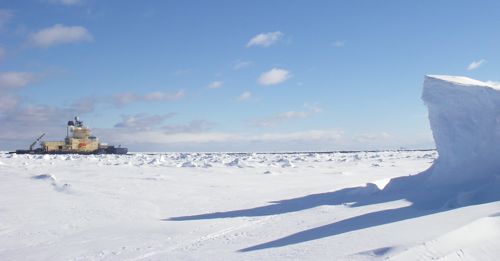Oden News Flash! Before we get to today's topic I need to make an announcement....
I learned today that some of my journal posts from this week were lost in the complex satellite cyberspace pathway from ship to satellite to Alaska to Internet to you! I have worked with the tech experts at PolarTREC and on the Oden today and hopefully by the time you get today's journal you will also have a few extra day's journals to enjoy as well. It is all part of communicating from the remote parts of the planet!
Today's topic is...
Seal Research aboard Oden
In 1955 an epidemic disease swept across the crabeater seal population of Antarctica and 97% of the crabeater seals (millions of individuals) died. Dr. Tero Härkönen from the Museum of Natural History in Sweden was among a group of scientists who came to Antarctic in the 1980's and was able to determine that the cause of the epidemic three decades earlier was the canine distemper virus. That group pointed out that it was likely that the seals had accidentally been exposed to the virus by the sled dogs that people then depended upon for Antarctic travel. Dr. Härkönen now leads the seal research team aboard the Oden as they launch the first major study of the health of Antarctic seals. Dr. Olle Karlsson, also from the Swedish museum and Dr. Jonas Tielmann from Denmark are attempting to collect the broadest range of data ever collected on Antarctic seal health. The Oden is giving the scientists access to all four Antarctic seal species that call the sea ice home. For many years their work has focused on similar seal epidemics in Europe, the Caspian Sea and Russia's Lake Baikal.
The team is collecting data on the bacteria and parasites carried by the seals as well as the levels of pollutants such as mercury that the seals are absorbing from their environment. One of the most interesting aspects of their work will involve a genetic analysis of the seals. If over 90% of the crabeater seals died in a disease epidemic over 50 years ago, it can be presumed that all of the more than 20 million crabeaters in Antarctica today are descendants of the epidemic survivors. If the scientists can compare the DNA of today's seals with the DNA of seals from before the epidemic, they may be able to document the evolutionary changes that have allowed the current population of seals to live with an endemic background level of distemper virus. To test this, Dr. Karlsson will helicopter out to the Dry Valleys after we arrive in McMurdo. Once there, he will locate the freeze-dried (naturally mummified) bodies of crabeater seals that naturally died there hundreds of years before the distemper epidemic. He will collect genetic samples from these ancient seals for comparison to seals the team samples on the Oden this year.
It is certain that all of this will greatly expand out scientific understanding of the way seals acquire and respond to diseases. Already, this kind of research was instrumental in protecting Antarctic seals because treaties now forbid anyone from bringing dogs (or any other foreign animal) to the isolated world of Antarctic wildlife. I hope you enjoy today's video.
Photo of the Day!
 My wife told me that today my home town, North of Syracuse, was suffering through another early winter, snow storm and my that my principal had wondered if my Antarctic adventures had somehow sent the bad weather that closed school today. Well, this is a photo I took today of the Oden surrounded by sea ice. The iceberg that you see on the right was frozen into the center of the floe we were working on so I skied out for a look. I hope everyone is having this nice of a day!
My wife told me that today my home town, North of Syracuse, was suffering through another early winter, snow storm and my that my principal had wondered if my Antarctic adventures had somehow sent the bad weather that closed school today. Well, this is a photo I took today of the Oden surrounded by sea ice. The iceberg that you see on the right was frozen into the center of the floe we were working on so I skied out for a look. I hope everyone is having this nice of a day!
Making memories on the ice,
Jeff Peneston

